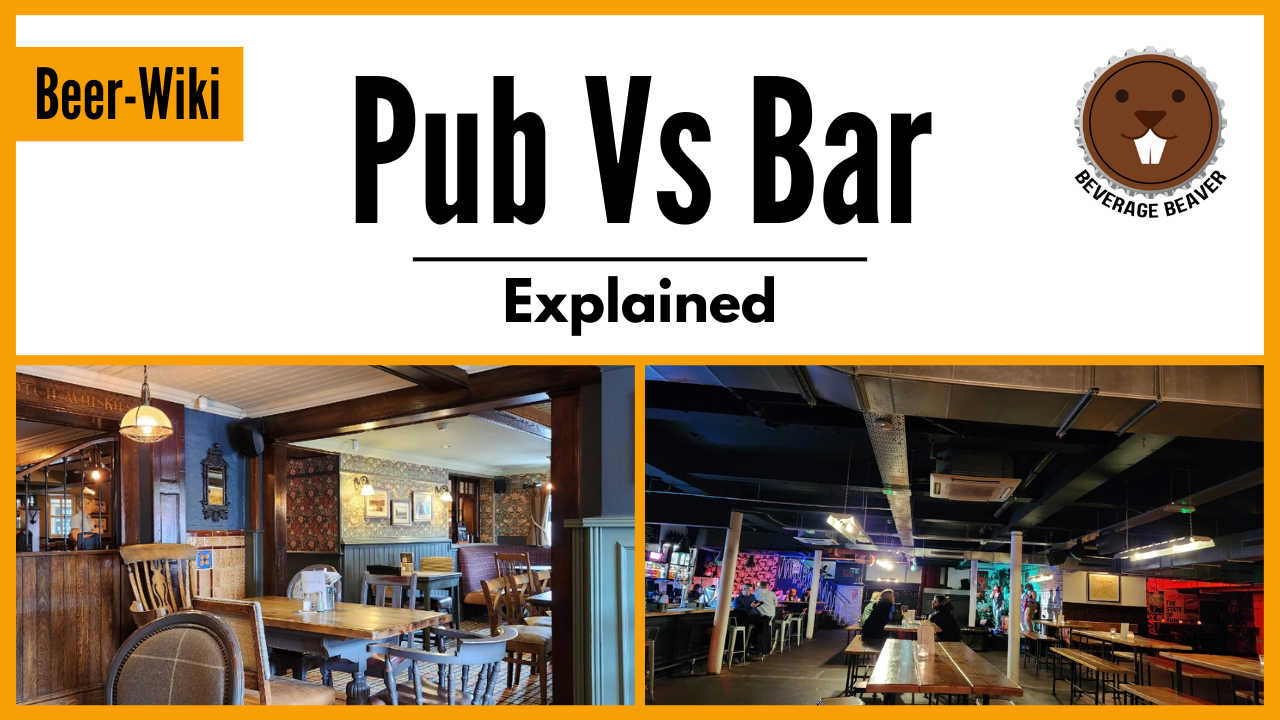Pub Vs Bar Explained | An Easy Guide To Understanding The Difference
For most British and Irish people, the difference between a pub and a bar is obvious. However, for people from other countries and cultures, this distinction is not so evident. So, let’s clear this up. What’s the difference between a pub and a bar?
Simply put, a pub – short for “public house” – is a community hub traditionally found in Britain and Ireland that serves beers, ales, and hearty meals in a cozy and traditional atmosphere. A bar, on the other hand, is more of a general drinking establishment that typically serves a wider variety of alcoholic drinks, from beers to cocktails. Unlike the cozy, traditional atmosphere of pubs, bars can have a wide range of styles, from sleek and modern to themed or divey. While both pubs and bars are places to drink, their cultural significance, ambiance, and offerings often differ.
Of course, that is the simple answer, and there are more nuanced differences between pubs and bars. Read on for a detailed explanation of these key differences and by the end of this article you’ll have no doubt whether to call your local drinking establishment a pub or a bar.
Pub Vs Bar: Key Differences
History
The history of the pub can be traced back to the Roman taverns in Britain. As Roman roads spread across the British Isles, so did these taverns, which served as essential pit stops for travelers offering food, drink, and sometimes lodging. As centuries rolled by and Roman influence waned, the concept evolved. By the time of the medieval period, the ‘alehouse’ or ‘inn’ had established itself as a central community venue.
Pubs played an essential role in the fabric of British and Irish societies. They were not just places to drink; they were community centers, venues for town meetings, and places to hear the latest news or gossip. The name “public house” reflects this broader role in the community. The signage outside traditional pubs, which often feature intriguing names and imagery, have tales of their own – from local legends to historical events.
The bar’s origin is more multifaceted, reflecting its global presence. While the concept of a drinking establishment is as old as civilization itself, what we recognize today as a bar has a myriad of influences. In Europe, wine and coffee houses that sprouted during the Renaissance provided some inspiration. Across the Atlantic, the saloons of the Wild West have their own tales to tell. As urbanization took hold in the 19th and 20th centuries, bars became synonymous with city life, nightlife, and modernity.
Bars often became melting pots in newly industrialized societies. They were places where the working class could rub shoulders with the bourgeoisie, where new musical styles emerged, and where revolutions, in both thought and action, were brewed. The emphasis at bars was less about community in the traditional sense and more about entertainment, socializing, and, in many instances, escapism.
Food And Drink
Both pubs and bars are popular establishments for socializing, but they differ significantly in terms of their food and drink offerings. When it comes to beverages, pubs primarily focus on draught beers and ciders, plus a selection of wines and spirits. In contrast, while bars also serve beers, both bottled and draught, they often offer a broader range of cocktails and may have a more extensive selection of wines and spirits.
The food offered in pubs and bars is also quite different. Pubs often prioritize traditional, hearty meals such as fish and chips, pies, bangers and mash, and even Sunday roasts. The ambiance in pubs is generally relaxed, making them ideal for family meals and prolonged get-togethers with friends.

Bars, especially in urban areas, might lean more towards the ambiance and music than food. When they do offer food, it’s typically snack-sized portions or appetizers suitable for sharing, such as nachos, sliders, or, in certain cultures, tapas. Additionally, many bars have specific themes or vibes, from tiki bars with tropical cocktails to wine bars showcasing curated selections.
Architecture And Atmosphere
Pubs and bars usually differ in terms of the architectural and atmospheric traits they exhibit. Pubs are often housed in aged buildings, reflecting centuries of British or Irish architecture. Their exteriors might feature stone or brickwork, and interiors usually have low ceilings, wooden beams, and cozy nooks. Such elements create a sense of history and warmth, which makes patrons feel at home in an ambiance of comfort and tradition.

Bars, on the other hand, tend to embrace modern designs. They are often housed in newer structures or renovated spaces and are characterized by open layouts, contemporary lighting, and sleek finishes. The atmosphere is typically lively and energetic, underscored by ambient music or trendy decors.
Opening Hours
Pubs and bars often have different opening times. Traditionally, pubs open earlier in the day compared to bars, usually around lunchtime or early afternoon. In contrast, bars typically begin serving in the early evening.
When it comes to closing, pubs traditionally shut their doors around 11pm, while bars often stay open late into the night. This distinction has become less pronounced in recent years, especially after the Licensing Act of 2003 permitted establishments to apply for more flexible hours. Consequently, it’s now not uncommon to find popular pubs, especially in bustling cities, open until the early morning hours. However, as a general rule, pubs tend to open earlier than bars, and bars often stay open later than pubs.
Pub Vs Bar FAQ
Are there pubs in America?
Yes, there are pubs in America. While they might not be as deeply rooted in tradition as their UK counterparts, many are inspired by the British and Irish pub culture and offer a similar ambiance and experience.
What’s the difference between a pub and a tavern?
Pubs originated in the UK and focused on serving a variety of beers and ales, often with a cozy, community atmosphere. Taverns, historically, are establishments that serve both food and drink, especially in colonial America. While both offer food and beverages, pubs emphasize the communal experience, while taverns traditionally catered to travelers and offered lodging.
Do pubs have live music?
Yes, many pubs, especially in the UK, feature live music. It’s common for local bands or solo artists to perform, particularly on weekends.
Why are some pubs called “inns”?
Historically, an “inn” provided lodging as well as food and drink, catering especially to travelers. While many establishments still use the term “inn” in their name, not all offer accommodation nowadays.
Are there dress codes in pubs?
Most traditional pubs don’t have strict dress codes, prioritizing a casual and relaxed atmosphere. However, some modern or upscale pubs in city centers might have a more specific dress standard.
Wrapping Up
Thanks for reading! I hope you now have a better understanding as to the difference between pubs and bars. When you’re next in a place serving drinks, and you’re pondering, “Is this a pub or a bar?”, ask yourself: “Am I in Britain or Ireland?” and “Is this place laid-back, traditional, and serves hearty meals?” A ‘yes’ to these probably means you’re in a pub. Otherwise, it’s likely a bar.

